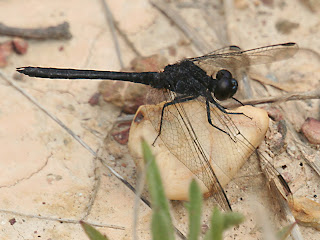This was first time that I’d visited the region in May, it was a rather a search and hope trip. Finding water, the correct spots, and lots of luck was required as I tried to use my knowledge of Odonata observing at home to find them in a new environment. However, I did manage to see 20 species during my break and compared to a regular mid-May total back in England, I think I chose the correct option!
Habitat visited included rivers, the top of the Algarve’s only mountain, ponds, brackish habitat, and various little small local water pumping stations and ditches during the search. Although it is easy enough to look at a map and think a site looks good, I lost count of the times I searched for water only to find the spot and discover it to be dry. The Iberian Peninsula as a whole has been very dry for well over a year now, and my Portuguese friends often comment ‘My bones are burning’. During one trip out, I noticed the outdoor temperature reading on the dashboard of the hire car read 49C… my bones certainly were burning!!!
One of the most delightful species of the trip was Copper Demoiselle.
Orange Featherleg was another species I was keen to see, this found at a couple of wetland habitats during my visit.
Like England, damselflies make up the most of the early-season species, though it was a surprise to note that Small Red Damselflies seemed to outnumber the more familiar Large Red Damselflies, but it was nice to catch up with the form melanotum of the latter, something I’ve only seen once back home.
The other damselflies seen during the trip included Common Winter Damselfly, Common Blue Damselfly, Iberian Blue-tailed Damselfly, Scarce Blue-tailed Damselfly and Goblet-marked Damselfly or Blue-eye as it is now called in the new school of names.
By far the commonest big dragonfly in the Algarve is the Emperor, this species noted at almost every site from sea level up to the top of the Mount Foia, where one greeted me on arrival at the mountain-top car park.
Another species in abundance was the Western Clubtail. This was another species noted in a variety of locations and habitats, while Four-spotted Chaser is a species more likely to be encountered in the north-western areas of the Algarve.
Epaulet Skimmer was a species that was new to me when I visited the area last autumn. Again it wasn’t easy to see this time, but I didn’t manage to increase my highest day count from a very low 2 to a rather impressive 3 individuals, these noted close to Aljezur.
Another species that was new to me in 2011 was Black Percher, when I noted an individual in the Boca Do Rio. It was rather pleasing to find several of this species as their flight season commenced and the exuviae.
So that was the Odonata…
The rest of it in a paragraph!
I did see some birds, about 115 species… which wasn’t so bad considering I didn’t do any birding... including Short-toed Eagles, Black-winged Kites, Collared Pratincoles… Stone Curlews displaying and uncountable numbers of singing Nightingales whilst observing the nice array of Odonata on show, Thekla Larks, Pallid Swifts, Alpine Swifts, the regular Shrikes, Bee-eaters, Greater Flamingos, Choughs, Blue Rock Thrushes, Rock Buntings, Melodious, Dartford, Subalpine Warblers… pause to breath (and to rest the typing finger!)… Iberian race of Green Woodpecker, Iberian form of Speckled Wood, Green Hairstreaks, Clouded Yellows, various not stop flying Fritillarys, Two-tailed Pashas, Monarchs, Swallowtails etc… crikey wish I’d read a guide book for places to visit… various tracks the hire car company would rather not know that I actually drove the car along, more European Pond Tortoises than I could count, a number of Orchids I would love to be able to identify, but I’ll never get round too, in fact lots of flowers… Portugal is brilliant when it has soft vegetation… numerous cows and goats, various beetles and other interesting looking inverts…
Even when I paused for a beer... Striped Hawk!
I'll probably never get round to knowing what the snakes were unless I do it all again and remember to take a photograph!
I wish to express my thanks to Nuno de Santos Loureiro for being kind enough to take me out for a day of Odonata spotting and providing me with maps of the western Algarve area for me to tour in search of water. By clicking here, you can view Nuno’s Algarve Odonata Atlas.
The Algarve… it is more than beaches and English bars! And even though it was too hot to do anything other than sit in the shade for over two days, I think I managed to get round to seeing enough to fill the time, but I know there is so much more to see, learn and discover... before the eco-tourists do!
















No comments:
Post a Comment